Influence of Rotation Speed on Flow Field and Hydraulic Noise in the Conduit of a Vertical Axial-Flow Pump under Low Flow Rate Condition
Abstract
:1. Introduction
2. Numerical Simulation Method
2.1. Model Parameter
2.2. Turbulence Model and Governing Equations
2.3. Grid Generation
2.4. Solver Control
2.5. Sound Numerical Method
3. Physical Model of the Axial-Flow Pump Device
3.1. Test Device and Test Method
3.2. Comprehensive Uncertainty Analysis
4. Results and Analysis
4.1. Numerical Calculation Verification
4.1.1. Comparison between Numerical Calculation Results and PIV Test
4.1.2. Comparison between Sound Field Simulation Results and Tests
4.2. Analysis of Internal Flow Characteristics in Conduit
4.3. Hydraulic Noise Analysis of Conduit
5. Conclusions
Author Contributions
Funding
Institutional Review Board Statement
Informed Consent Statement
Data Availability Statement
Conflicts of Interest
Nomenclature
| Qbep | Flow rate of best efficiency point (m3/s) |
| CFD | Computational Fluid Dynamics |
| CA | Computational Acoustics |
| FEM | Acoustic Finite Element Method |
| BEM | Acoustic Boundary Element Method |
| TSSI | Total Sound Source Intensity |
| SSI | Sound Source Intensity |
| dB | Decibel |
| T | Rotation period |
| D | Diameter of impeller (m) |
| atm | Standard atmospheric pressure |
| n | Rotational speed (r/min) |
| PIV | Particle Image Velocimetry |
| y+ | Dimensionless wall distance |
| ρ | Density of water (kg/m3) |
| t | Time (s) |
| u | Velocity (m/s) |
| x | Coordinate (m) |
| p | Pressure (Pa) |
| μ | Dynamic viscosity (Pa·s) |
| i, j | Coordinate axis directions |
| c0 | Sound velocity |
| EQ | System uncertainty of flow measurement |
| EH | System uncertainty of static head measurement |
| EM | System uncertainty of torque measurement |
| EN | System uncertainty of speed measurement |
| Sη | Standard deviation of the average efficiency |
| Total uncertainty of efficiency (%) | |
| Systematic uncertainty of the experimental system (%) | |
| Random uncertainty of the experimental system (%) | |
| Sef | Effective value of sound source in time domain |
| Sref | Reference sound source |
| nm | Number of frequencies |
References
- Liu, C. Researches and Developments of Axial-flow Pump System. Trans. Chin. Soc. Agric. Mach. 2015, 46, 49–59. [Google Scholar] [CrossRef]
- Mao, Z.B.; Lizuka, T.; Maeda, S. Bidirectional electrohydrodynamic pump with high symmetrical performance and its application to a tube actuator. Sens. Actuators A Phys. 2021, 332, 113168. [Google Scholar] [CrossRef]
- Mao, Z.B.; Nagaoka, T.; Yokata, S.; Kim, J. Soft fiber-reinforced bending finger with three chambers actuated by ECF (electro-conjugate fluid) pumps. Sens. Actuators B Chem. 2020, 310, 112034. [Google Scholar] [CrossRef]
- Bueker, J.; Lass, A.; Werner, P.; Wurm, F.-H. Active noise cancellation applied to a centrifugal pump in a closed loop piping system. Appl. Acoust. 2021, 178, 108003. [Google Scholar] [CrossRef]
- Murovec, J.; Curovic, L.; Novakovic, T.; Prezelj, J. Psychoacoustic approach for cavitation detection in centrifugal pumps. Appl. Acoust. 2020, 165, 107323. [Google Scholar] [CrossRef]
- Orhan, N.; Ozbek, O.; Seflek, A.Y. The Effect of Nominal Diameter and Water Inlet Cross-Sectional Area on Some Pump Parameters in Vertical Shaft Deep Well Pumps. Ksu Tarim Ve Doga Derg. -Ksu J. Agric. Nat. 2020, 23, 237–246. [Google Scholar] [CrossRef]
- Cernetic, J. The use of noise and vibration signals for detecting cavitation in kinetic pumps. Proc. Inst. Mech. Eng. Part C J. Mech. Eng. Sci. 2009, 223, 1645–1655. [Google Scholar] [CrossRef]
- Orhan, N.; Seflek, A.Y.; Ozbek, O. Effects of Submergence Change in Shaft Pumps on Some Pump Parameters. Ksu Tarim Ve Doga Derg. -Ksu J. Agric. Nat. 2021, 24, 747–756. [Google Scholar] [CrossRef]
- Choi, J.S.; McLaughlin, D.K.; Thompson, D.E. Experiments on the unsteady flow field and noise generation in a centrifugal pump impeller. J. Sound Vib. 2003, 263, 493–514. [Google Scholar] [CrossRef]
- Guo, C.; Gao, M.; Wang, J.; Shi, Y.; He, S. The effect of blade outlet angle on the acoustic field distribution characteristics of a centrifugal pump based on Powell vortex sound theory. Appl. Acoust. 2019, 155, 297–308. [Google Scholar] [CrossRef]
- Chen, E.Y.; Ma, Z.L.; Zhao, G.P.; Li, G.P.; Yang, A.L.; Nan, G.F. Numerical investigation on vibration and noise induced by unsteady flow in an axial-flow pump. J. Mech. Sci. Technol. 2016, 30, 5397–5404. [Google Scholar] [CrossRef]
- Huang, X.C.; Shi, S.K.; Su, Z.W.; Rao, Z.Q.; Hua, H.X. Vibro-acoustic responses of a pump-jet under distributed unsteady hydrodynamic forces. J. Vib. Shock. 2021, 40, 89–94+113. [Google Scholar] [CrossRef]
- Zhang, D.S.; Zhang, N.S.; Xu, B.; Zhao, R.J.; Gao, X.F.; Li, N. Numerical simulation of the flow-induced noise in a water-jet pump based on the Lighthill acoustic analogy theory. J. Vib. Shock. 2021, 40, 278–287. [Google Scholar] [CrossRef]
- Zheng, Y.; Chen, Y.J.; Mao, X.L.; Wang, H.Z.; Shi, W.; Kan, K.; Zhang, Y.Q. Pressure pulsation characteristics and its impact on flow-induced noise in mixed-flow pump. Trans. Chin. Soc. Agric. Eng. 2015, 31, 67–73. [Google Scholar] [CrossRef]
- Choi, J.; Seol, H.; Park, I.; Lee, S. Study on noise prediction of non-cavitating underwater propeller with hull-appendages effect. J. Acoust. Soc. Korea 2019, 38, 247–255. [Google Scholar] [CrossRef]
- Mao, X.; Pavesi, G.; Chen, D.; Xu, H.; Mao, G. Flow induced noise characterization of pump turbine in continuous and intermittent load rejection processes. Renew. Energy 2019, 139, 1029–1039. [Google Scholar] [CrossRef]
- Wu, D.; Liu, Y.; Li, D.; Zhao, X.; Li, C. Effect of materials on the noise of a water hydraulic pump used in submersible. Ocean. Eng. 2017, 131, 107–113. [Google Scholar] [CrossRef]
- Fu, J.; Song, Z.H.; Wang, Y.S.; Jin, S.B. Numerical predicting of hydroacoustic of pumpjet propulsor. J. Ship Mech. 2016, 20, 613–619. [Google Scholar] [CrossRef]
- Zhao, H.R.; Wang, F.J.; Wang, C.Y.; Chen, W.H.; Yao, Z.F.; Shi, X.Y.; Li, X.Q.; Zhong, Q. Study on the characteristics of horn-like vortices in an axial flow pump impeller under off-design conditions. Eng. Appl. Comput. Fluid Mech. 2021, 15, 1613–1628. [Google Scholar] [CrossRef]
- Si, Q.R.; Shen, C.H.; He, X.K.; Li, H.; Huang, K.L.; Yuan, J.P. Numerical and Experimental Study on the Flow-Induced Noise Characteristics of High-Speed Centrifugal Pumps. Appl. Sci. 2020, 10, 3105. [Google Scholar] [CrossRef]
- Si, Q.R.; Sheng, G.C.; Heng, Y.G.; Cui, Q.L.; Huang, K.L. Numerical simulation for flow-induced noise in a centrifugal pump based on Lighthill acoustic analogy theory. J. Vib. Shock. 2018, 37, 84–90+97. [Google Scholar] [CrossRef]
- Kan, K.; Zheng, Y.; Chen, Y.J.; Xie, Z.S.; Yang, G.; Yang, C.X. Numerical study on the internal flow characteristics of an axial-flow pump under stall conditions. J. Mech. Sci. Technol. 2018, 32, 4683–4695. [Google Scholar] [CrossRef]
- Yang, F.; Gao, H.; Liu, C.; Zhao, H.R.; Tang, F.P. Experiment Analysis on Flow-induced Pulsation and Noise in Outlet Conduit of Vertical Axial-flow Pumping System. Trans. Chin. Soc. Agric. Mach. 2018, 49, 144–149. [Google Scholar] [CrossRef]
- Yang, F.; Jiang, D.J.; Wang, T.L.; Chang, P.C.; Liu, C.; Liu, D.S. Investigation into the Influence of Division Pier on the Internal Flow and Pulsation in the Outlet Conduit of an Axial-Flow Pump. Appl. Sci. 2021, 11, 6774. [Google Scholar] [CrossRef]
- Yang, F.; Zhao, H.R.; Liu, C.; He, J.Y.; Tang, F.P. Experiment and Analysis on Outlet Flow Pattern and Pressure Fluctuation in Inlet Conduit of Vertical Axial-flow Pumping System. Trans. Chin. Soc. Agric. Mach. 2017, 48, 141–146. [Google Scholar] [CrossRef]
- Yang, F.; Liu, C.; Tang, F.P.; Zhou, J.R. Analysis of Hydraulic Performance of Outlet Passage Based on Simulation of Steady Flow in Whole Passage of Axial-flow Pumping System. Trans. Chin. Soc. Agric. Mach. 2017, 48, 83–89. [Google Scholar] [CrossRef]
- Yang, F.; Li, Z.B.; Fu, J.G.; Lv, Y.T.; Ji, Q.W.; Jian, H.F. Numerical and Experimental Analysis of Transient Flow Field and Pressure Pulsations of an Axial-Flow Pump Considering the Pump–Pipeline Interaction. J. Mar. Sci. Eng. 2022, 2, 258. [Google Scholar] [CrossRef]
- Zhang, J.F.; Jia, J.; Hu, R.X.; Wang, Y.; Cao, P.Y. Flow Noise of Pipeline Pump and Bionic Acoustic Optimization. Trans. Chin. Soc. Agric. Mach. 2018, 49, 138–145. [Google Scholar] [CrossRef]
- Tan, M.G.; Lu, Y.D.; Wu, Z.J.; Wu, X.F.; Liu, H.L. Effects of blade number on flow induced vibration and noise in centrifugal pump. Trans. Chin. Soc. Agric. Eng. 2019, 35, 73–79+320. [Google Scholar] [CrossRef]
- Kan, K.; Yang, Z.X.; Lyu, P.; Zheng, Y.; Shen, L. Numerical study of turbulent flow past a rotating axial-flow pump based on a level-set immersed boundary method. Renew. Energy 2021, 168, 960–971. [Google Scholar] [CrossRef]
- Dong, L.; Dai, C.; Lin, H.-B.; Chen, Y.-P. Noise comparison of centrifugal pump operating in pump and turbine mode. J. Cent. South Univ. 2018, 25, 2733–2753. [Google Scholar] [CrossRef]
- Predin, A.; Kastrevc, M.; Bilus, I. Radial pump operating noise and casing vibration analyses. Strojarstvo 2000, 42, 137–147. [Google Scholar]
- Liu, X.; Liu, J.; Jia, L.; He, J.; Zhang, J. Performance analysis of a centrifugal pump based on noise. Sci. Technol. Built Environ. 2021, 27, 1256–1268. [Google Scholar] [CrossRef]
- Zi, D.; Wang, F.J.; Tao, R.; Hou, Y.K. Research for impacts of boundary layer grid scale on flow field simulation results in pumping station. J. Hydraul. 2016, 47, 139–149. [Google Scholar] [CrossRef]
- Fiebig, W. Influence of the Inter Teeth Volumes on the Noise Generation in External Gear Pumps. Arch. Acoust. 2014, 39, 261–266. [Google Scholar] [CrossRef]
- Lang, T.; Shi, W.D.; Chen, K.; Li, W.; Ji, L. Flow field in forward-extended double blades centrifugal pump at different specific speeds. Trans. Chin. Soc. Agric. Mach. 2015, 46, 89–95. [Google Scholar] [CrossRef]
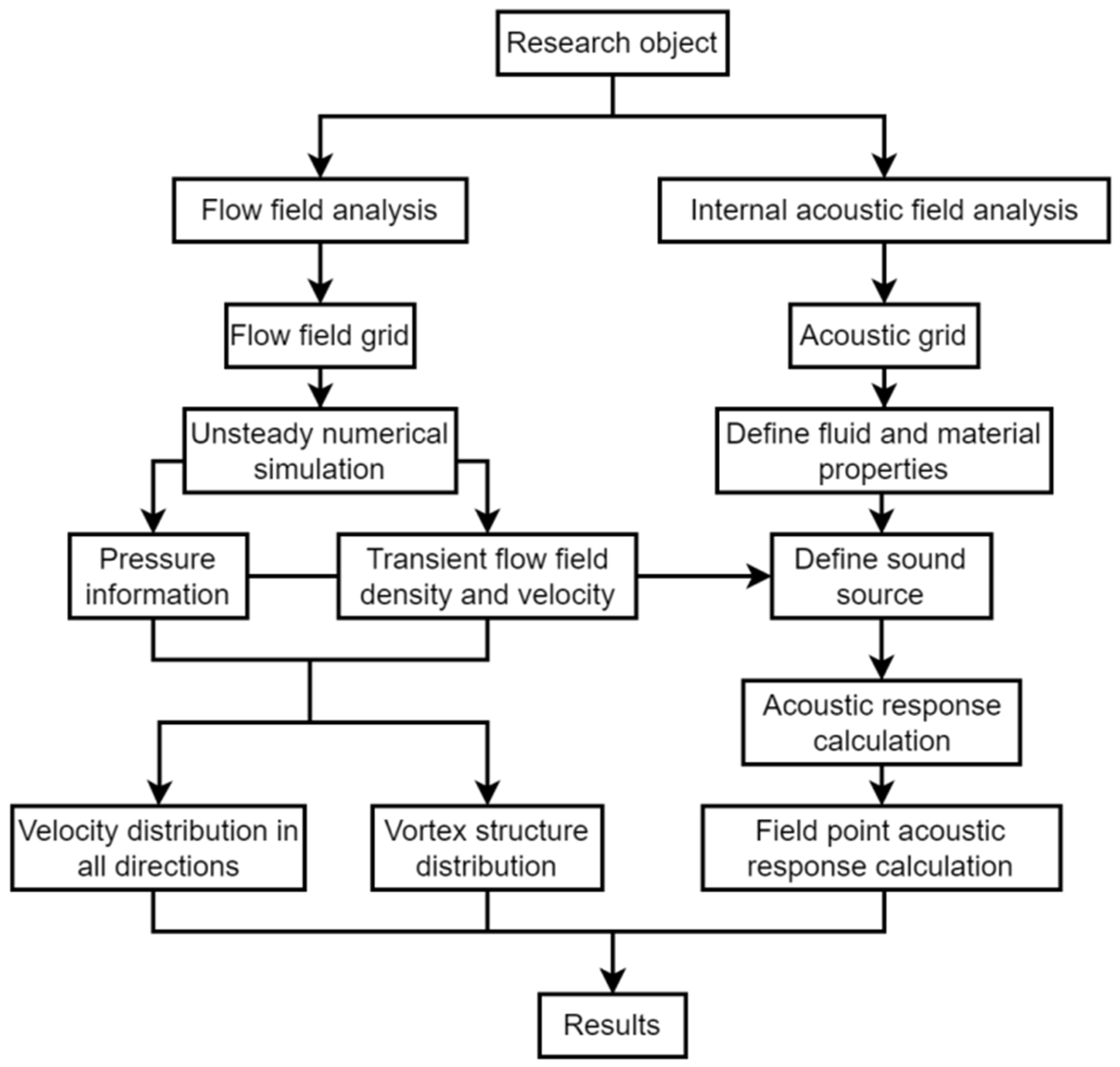

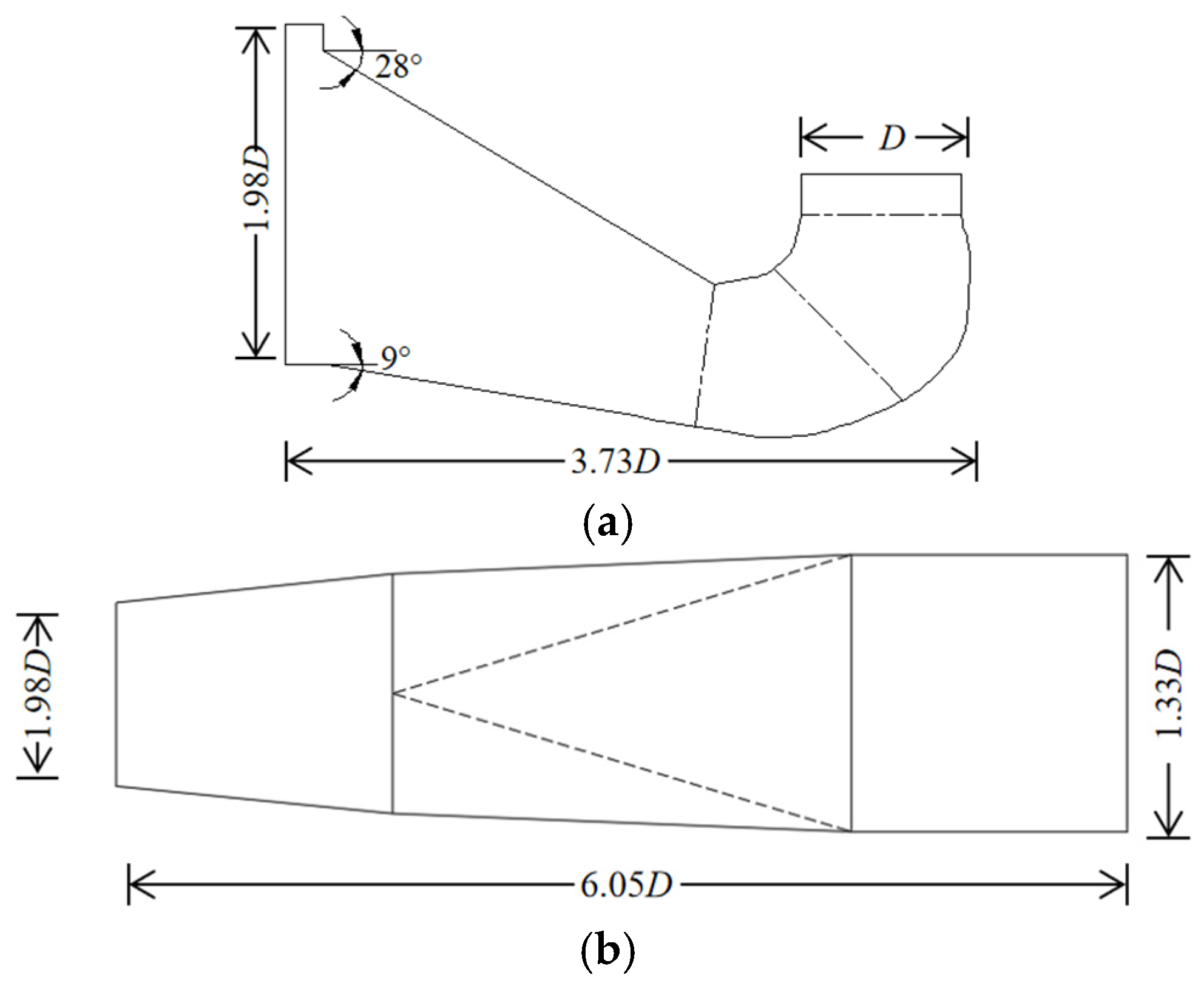
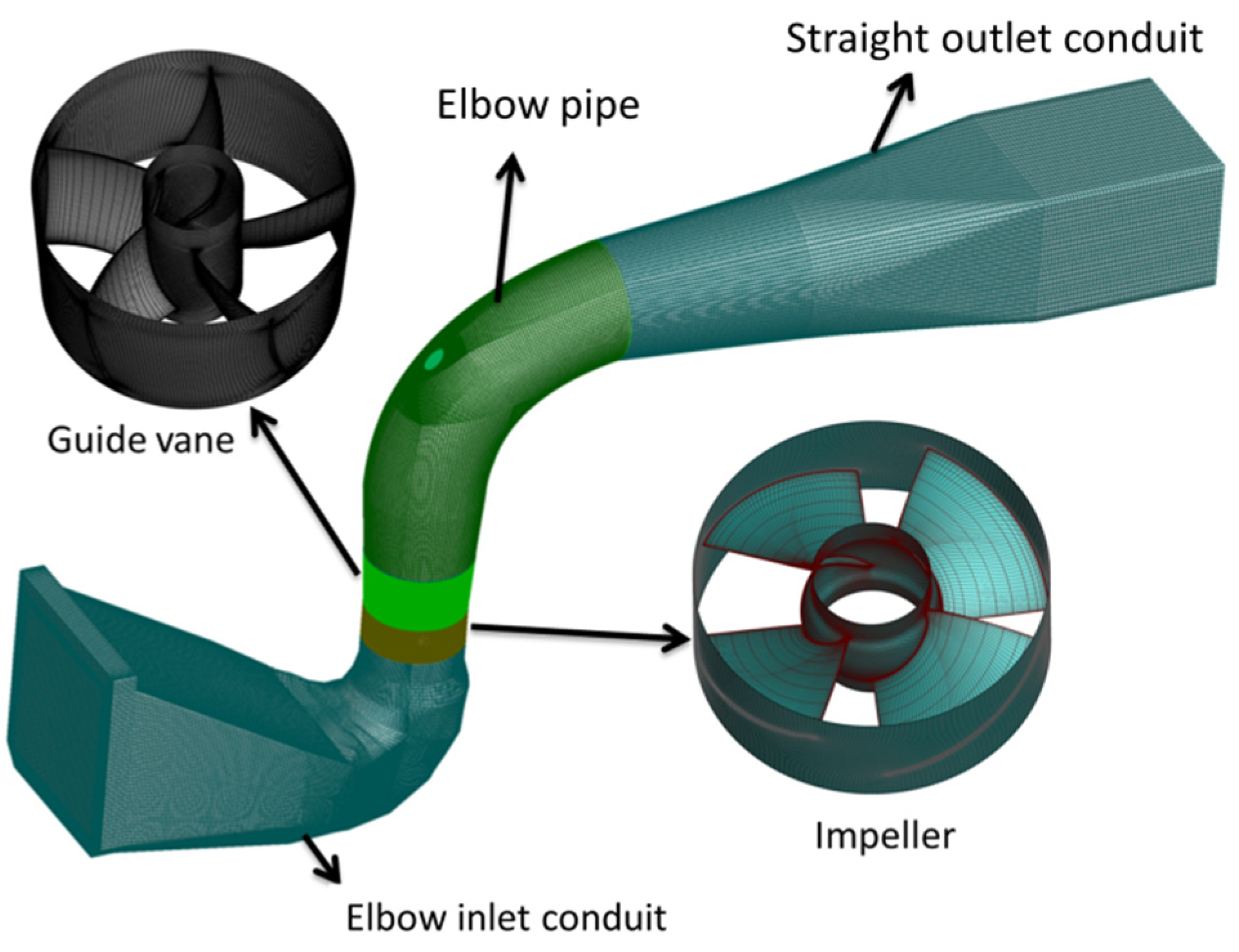

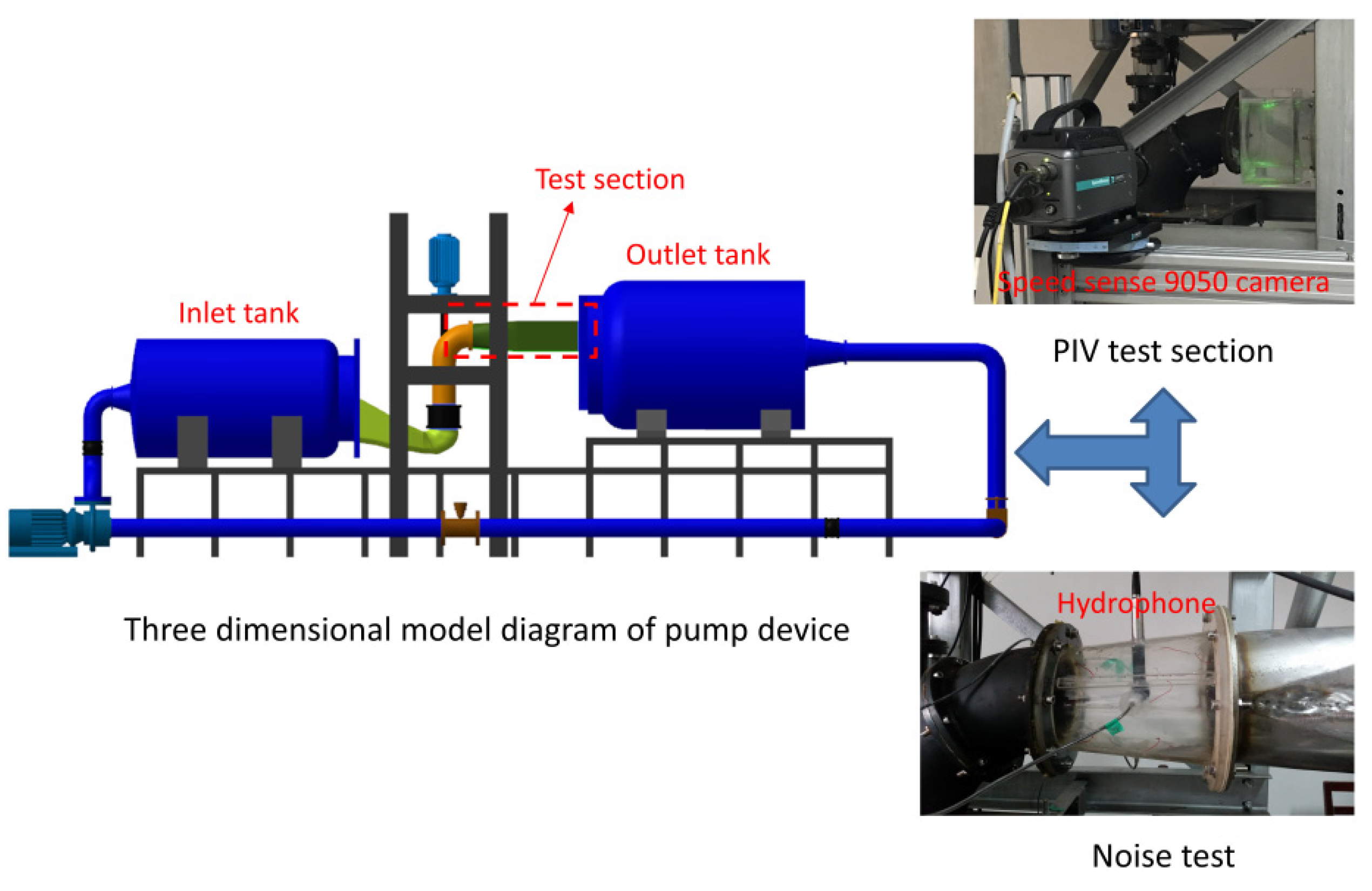
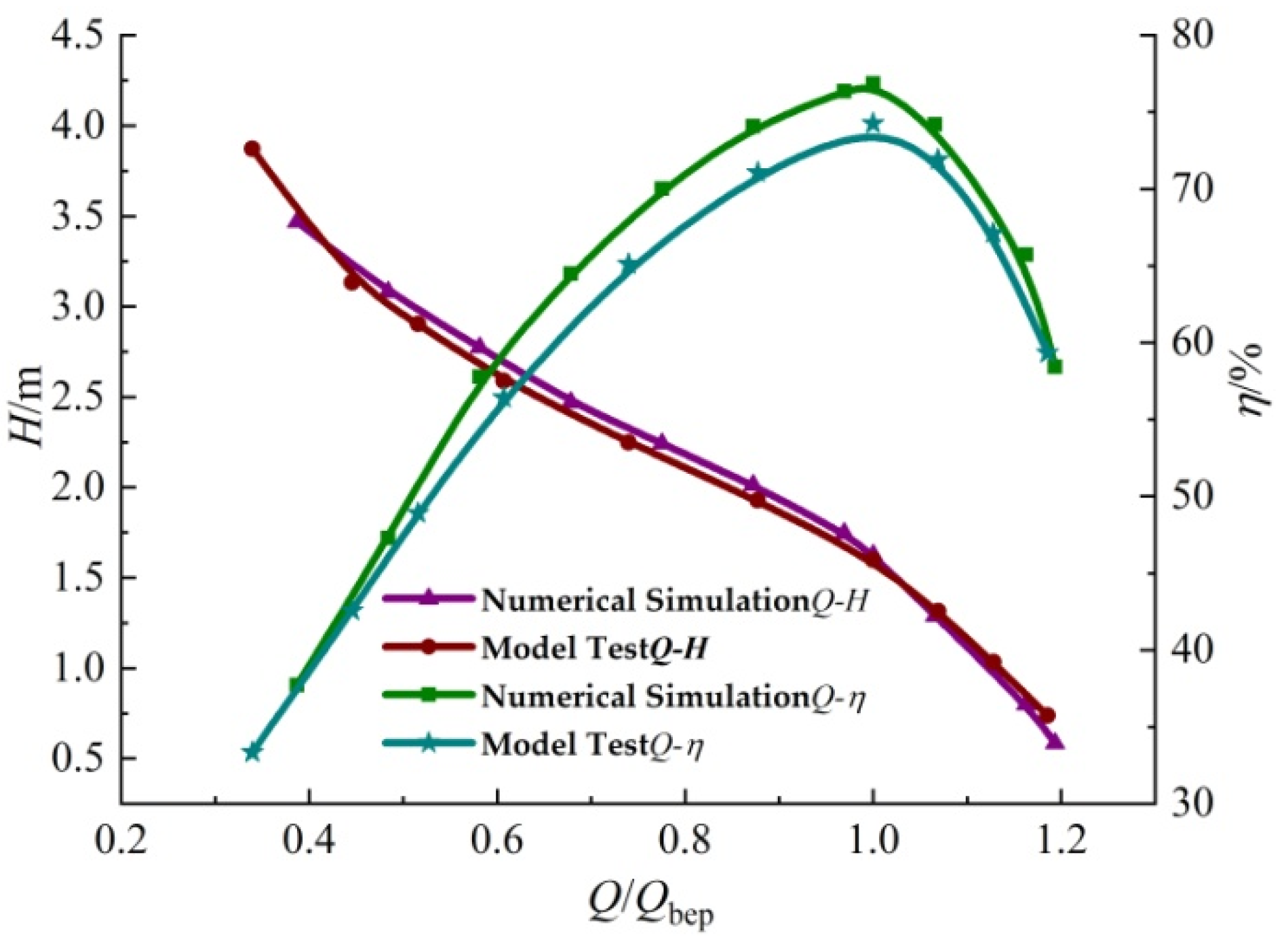

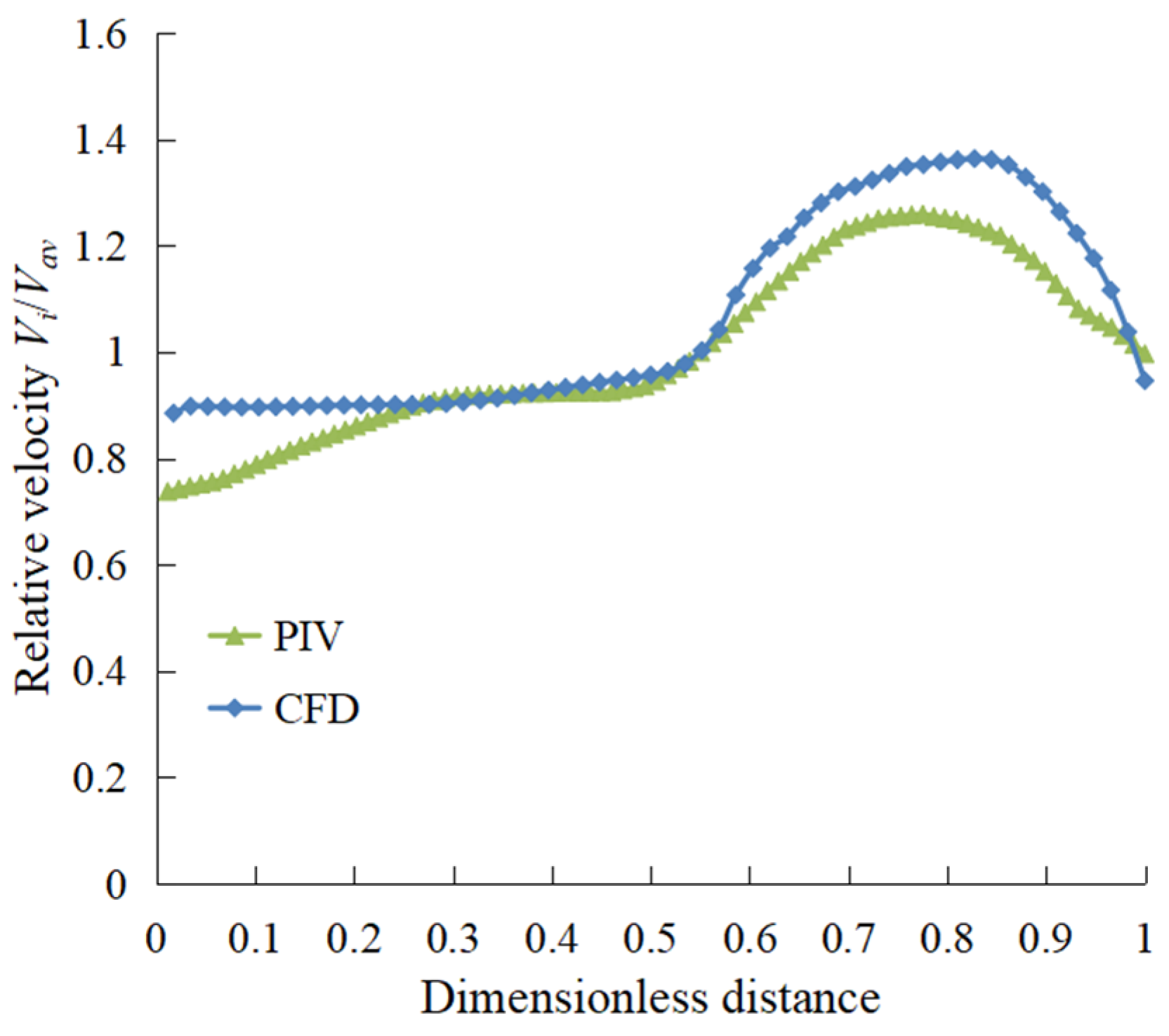
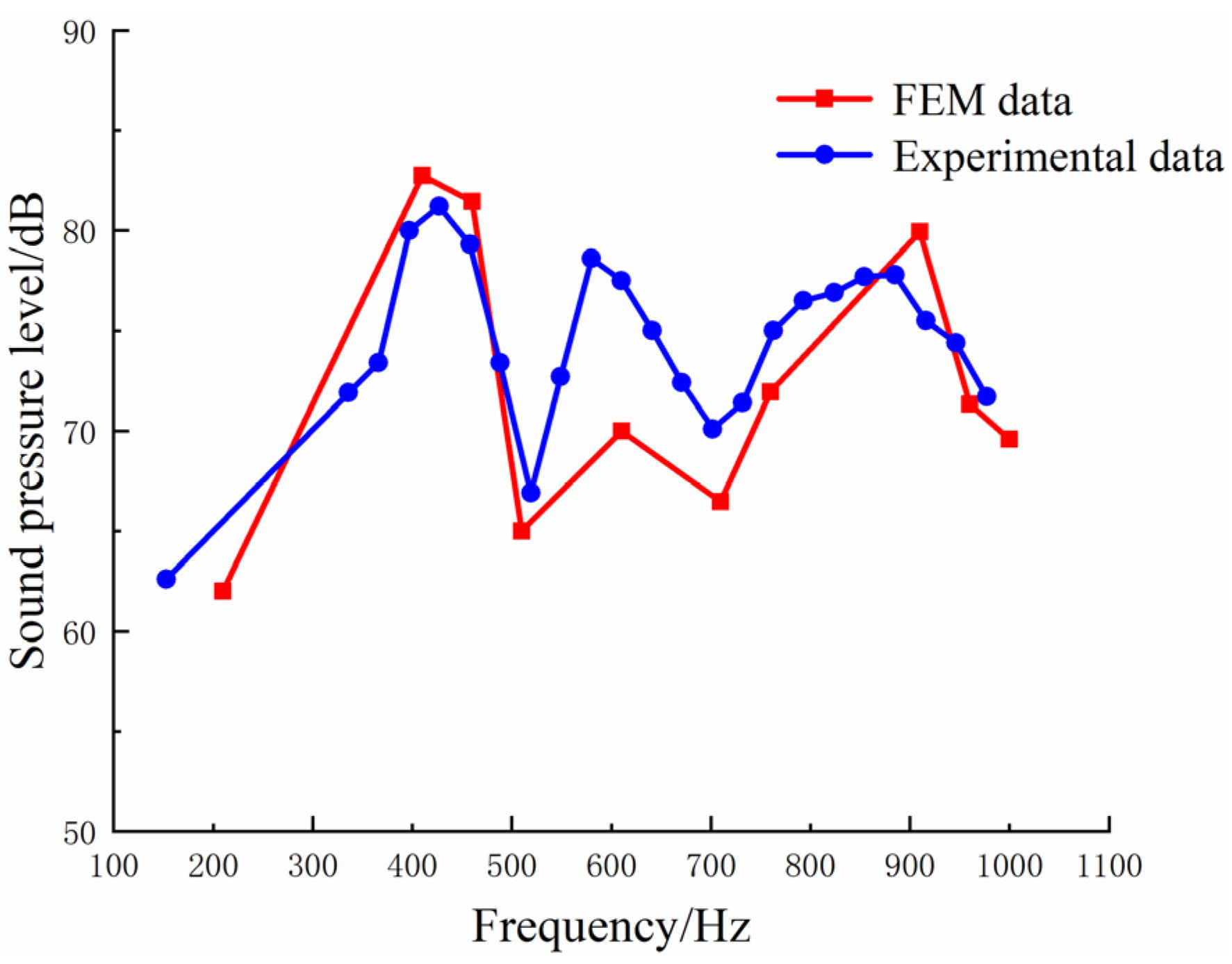

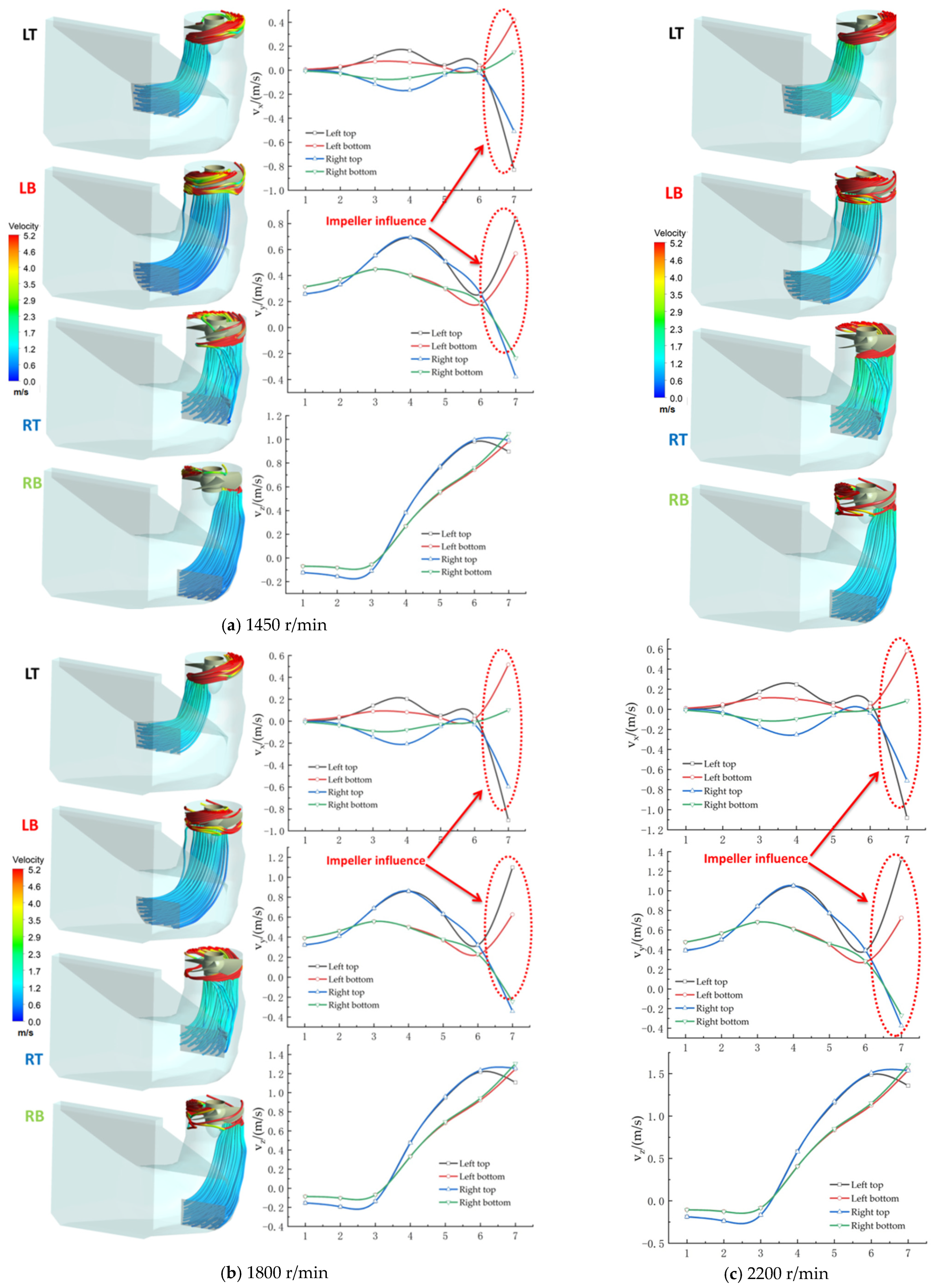


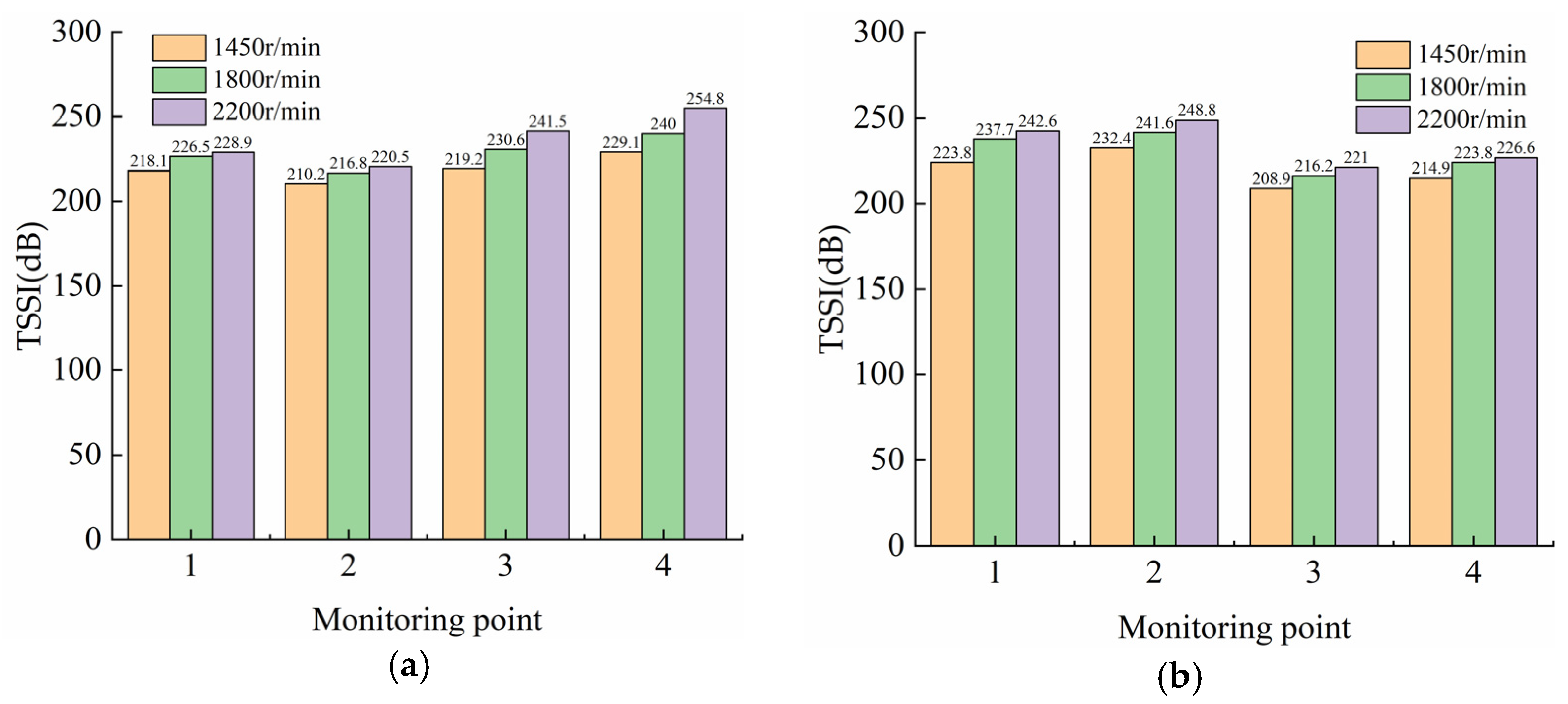
| Number of Grids (104) | 215 | 260 | 310 | 388 | 510 | 540 | 600 | 700 |
| Efficiency (%) | 76.03 | 76.16 | 76.50 | 76.76 | 76.86 | 76.85 | 76.85 | 76.85 |
| Inlet conduit | Rotation speed | 1450 r/min | 1800 r/min | 2200 r/min |
| 2.31 × 105 | 2.30 × 105 | 3.32 × 105 | ||
| Outlet conduit | Rotation speed | 1450 r/min | 1800 r/min | 2200 r/min |
| 2.07 × 105 | 1.96 × 105 | 1.92 × 105 |
Publisher’s Note: MDPI stays neutral with regard to jurisdictional claims in published maps and institutional affiliations. |
© 2022 by the authors. Licensee MDPI, Basel, Switzerland. This article is an open access article distributed under the terms and conditions of the Creative Commons Attribution (CC BY) license (https://creativecommons.org/licenses/by/4.0/).
Share and Cite
Yang, F.; Jiang, D.; Yuan, Y.; Lv, Y.; Jian, H.; Gao, H. Influence of Rotation Speed on Flow Field and Hydraulic Noise in the Conduit of a Vertical Axial-Flow Pump under Low Flow Rate Condition. Machines 2022, 10, 691. https://doi.org/10.3390/machines10080691
Yang F, Jiang D, Yuan Y, Lv Y, Jian H, Gao H. Influence of Rotation Speed on Flow Field and Hydraulic Noise in the Conduit of a Vertical Axial-Flow Pump under Low Flow Rate Condition. Machines. 2022; 10(8):691. https://doi.org/10.3390/machines10080691
Chicago/Turabian StyleYang, Fan, Dongjin Jiang, Yao Yuan, Yuting Lv, Hongfu Jian, and Hui Gao. 2022. "Influence of Rotation Speed on Flow Field and Hydraulic Noise in the Conduit of a Vertical Axial-Flow Pump under Low Flow Rate Condition" Machines 10, no. 8: 691. https://doi.org/10.3390/machines10080691
APA StyleYang, F., Jiang, D., Yuan, Y., Lv, Y., Jian, H., & Gao, H. (2022). Influence of Rotation Speed on Flow Field and Hydraulic Noise in the Conduit of a Vertical Axial-Flow Pump under Low Flow Rate Condition. Machines, 10(8), 691. https://doi.org/10.3390/machines10080691







